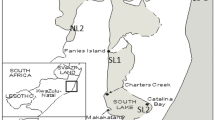Abstract
Five species of fishes, two species of aquatic macrophytes, zooplankton, migratory goose feces, water and sediments from a eutrophic lake were analyzed for mercury, cadmium, lead and thallium. Mercury was detected in fishes and sediments only while cadmium and lead were detected in all components. Thallium was detected only in sediments. Sediments in the lake act as a ‘sink’ for the four metals.
Mercury in axial musculature of largemouth bass was highly correlated with length and weight. A high degree of correlation between other metals and weight and length of other species was not evident.
The feces of migratory waterfowl had high concentrations of both cadmium and lead. In view of the large quantity of waterfowl feces deposited within the drainage basin, it is suggested that this avenue is one of the major sources of contamination for the two metals and that fallout from airborne particulate matter is secondary. Fallout of airborne particulate matter may be the primary method by which mercury and thallium enter the lake although residual concentrations of the four metals in soil of the drainage basin were not determined.
Similar content being viewed by others
References
Bowen, H. J. M. - 1966 - Trace elements in biochemistry. Academic Press, London and New York. 241 p.
Browning, E. - 1968 - Toxicity of industrial metal. 2nd edition. Butterworths, London, 383 p.
Craig, Sally - 1967 - Toxic ions in bivalves. J. Amer. Osteopat. Assoc., 66: 1000–1002.
D'Itri, Frank M. - 1971 - The environmental mercury problem— a report to the Michigan House of Representatives. Institute of Water Research, Michigan State University, Technical Report No. 12. 289 p.
D'Itri, Frank M., Annett, C. S. & Fast, A. W. - 1971a - Comparison of mercury levels in an oligotrophic and a eutrophic lake. Mar. Sci. 5 (6) ; 10–14.
D'Itri, Frank M., Annett, C. S., Fadow, M. P. & Bahr, T. G.- 1971b - An estimation of the total mercury content in some Lake Lansing fish and sediments. Institute of Water Research and Department of Fisheries and Wildlife, Michigan State University, 35 p.
Eyman, L. Dean - 1972 - Cesium-137 and stable cesium in a hypereutrophic lake. Unpublished Ph. D. thesis, Michigan State Univ., 98 p.
Fimreite, N., Holsworth, W. N., Keith, J. A., Pearce, P. A. & Gruchy, I. M. - 1971 - Mercury in Fish and Fish-eating Birds Near Sites of Industrial Contamination in Canada. Can. Field Nat. 85(3): 211–220.
Friberg, Lars, Piscator, M. & Nordberg, G. - 1971 - Cadmium in the environment. CRC Press, Cleveland, Ohio. 166 p.
Hiltibran, R. C. - 1971 - Effects of cadmium, zinc, manganese, and calcium on oxygen and phosphate metabolism of bluegill liver mitochondria. Water Pollu. Cont. Fed. 43(5): 818–823.
Hannerz, Lennart - 1968 - Experimental investigations of the accumulation of mercury in water organisms. Fishery Board of Sweden, Institute of Freshwater Research, Drottningholm, Report No. 48: 120–176.
Hasselrot, Torsten B. - 1968 - Report on current field investigations concerning the mercury content in fish, bottom sediments, and water. Fishery Board of Sweden, Institute of Freshwater Research, Drottningholm, Report No. 48: 102–111.
Huckabee, John W. - 1972 - Mercury concentrations in fish of the Great Smokey Mountains National Park. Oak Ridge National Laboratory, Oak Ridge Tennessee, Publication No. 479, 17p.
Huckabee, John W. & Blaylock, B. G. - 1972 - Transfer of mercury and cadmium from terrestrial to aquatic ecosystems. Environmental Sciences Division, Oak Ridge National Laboratory, Oak Ridge, Tennessee, 55 p.
Jackim, Eugene, Hamlin, J. M. & Sonis, S. - 1970 - Effects of metal poisoning on five liver enzymes in the killifish (Fundulus heteroclitus). J. Fish, Res. Board Can., 27(2): 383–390.
Johnels, A. G., Westermark, T., Berg, W., Persson, P, & Sjostrand, B. - 1967 - Pike (Esox lucius L.) and some other aquatic organisms in Sweden as indicators of mercury contamination in the environment. Oikos 18(2): 323–333.
Mathis, B. J. & Cummings, T. F. - 1971 - Distributions of selected metals in bottom sediments, water, clams, tubificid annelids and fishes of the middle Illinois River. University of Illinois Water Recources Research Center, Research Report. No. 41: 45 p.
Matida, Yoshihiro & Hiroshi, kumada - 1969 - Distribution of mercury in water, bottom mud and aquatic organisms of Minamata Bay, the River Agano and other water bodies in Japan. Bull. Freshwater Fish. Res. Lab. Tokyo 19 (2): 73–93.
Mckee, Jack E. & Wolf, Harold W. - 1963 - Water quality criteria. 2nd edition. The Resources Agency of California State Water Quality Control Board. Publication No. 3 - A, 548 p.
Wobeser, G., Nielsen, N. O., Dunlop, R. H. & Atton, F. M. - 1970 - Mercury concentrations in tissues of fish from the Saskatchewan River. J. Fish. Res. Board Can. 27 (4): 830–834.
Author information
Authors and Affiliations
Rights and permissions
About this article
Cite this article
Mathis, B.J., Kevern, N.R. Distribution of mercury, cadmium, lead and thallium in a eutrophic lake. Hydrobiologia 46, 207–222 (1975). https://doi.org/10.1007/BF00043141
Received:
Issue Date:
DOI: https://doi.org/10.1007/BF00043141




